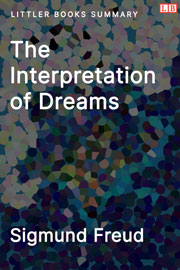Book Description
Through a psychoanalytic lens, Freud's seminal book delves into how dreams reflect our innermost wishes.
If You Just Remember One Thing
Coming soon.
Bullet Point Summary and Quotes
- The scientific understanding of dreams has progressed little over thousands of years. The dream's fundamental nature remains largely unresolved.
- Ancient views considered dreams divine or prophetic, a concept still echoed in some philosophical schools. Modern science focuses on psychological and physiological explanations.
- Memory in dreams is selective and peculiar. We often recall insignificant details while omitting important events.
- The relationship between dreams and waking life is debated. Some assert that dreams continue waking thoughts and others argue they remove us from reality, though it's generally agreed that dream material originates from past experiences.
- Dreams are the product of two mental processes: first, unconscious forces create a wish that the dream
fulfills, and second, a censorship mechanism distorts this wish's manifestation to maintain a favorable
self-image. Therefore, some dreams are direct (e.g., dreaming of winning the lottery), while other unpleasant
dreams fulfill hidden wishes that are suppressed and distorted by the psyche. Ultimately, all dreams are wish
fulfillments.
- “Everyone has wishes which he would not like to tell to others, which he does not want to admit even to himself.”
- Freud dreamed of three people -- Otto, Dr. M, and Irma -- where Dr. M revealed Irma's illness was caused by Otto's use of a dirty needle. The dream reflected Freud's wish to absolve himself of guilt for Irma's illness in waking life.
- Freud had a patient who dreamed of her nephew's death, which secretly represented her suppressed desire to see a professor who she only saw during funerals.
- Dreams often incorporate experiences and memories from the previous day, either directly or through associations with other thoughts and memories.
- Significant childhood experiences, especially those linked to strong emotions, can resurface in dreams, often connected to recent events.
- Physical sensations experienced during sleep can be incorporated into the dream narrative.
- A full bladder can lead to dreams related to water.
- Dreams heavily condense information, combining multiple experiences and thoughts into single elements. This is why we can have multiple dreams in one night. Although, those dreams often have the same meaning.
- Important emotions or thoughts are shifted onto insignificant objects or events within the dream. This is called displacement.
- The psyche creates a semblance of logical narrative in the dream by filling in gaps and connecting seemingly incoherent elements.
- Dreams can directly reflect real-life events (e.g., seeing something then later dreaming of it) or indirectly represent thoughts and impressions through symbols (e.g., thinking someone is "on their high horse" and dreaming they are on a horse).
- Many people share similar dreams. This suggests our unconscious has things in common.
- Dreams of public nudity are linked to repressed childhood exhibitionist desires, which were once innocent but later discouraged. The embarrassment felt in the dream is a distortion masking the underlying wish.
- Dreams of flying or falling may originate from a wish to relive the sensations of being lifted and bounced as a child.
- Dreams about a loved one's death can reflect a child's desire for more undivided parental attention.
- Repressed sexual impulses play a significant role in dream formation. Many dreams contain sexual symbolism.
- Elongated objects (e.g., sticks, tree-trunks, umbrellas) represent the male genitals.
- Enclosed spaces (e.g., boxes, caskets, closets) represent the female genitals.
- Children develop early sexual desires for the parent of the opposite sex, manifesting as a desire for the
parent's attention and intimacy.
- Parents often reciprocate by being stricter with children of their own gender while being more indulgent with children of the opposite gender.
- Children may unconsciously wish for the death of a same-gender parent to maintain an exclusive relationship with the opposite-gender parent.
- “Our memory really knows no guarantees, and yet, much more often than is objectively justified, we yield to the pressure of lending credence to its statements.”
- Dream analysis provides insights into our psyche by revealing suppressed wishes in the unconscious. By interpreting dreams, clinicians can understand and potentially treat psychological conditions like psychosis and neurosis, where repressed wishes break through conscious barriers.
- No dream associations are truly random. Seemingly random connections can still uncover insights about a patient's inner experiences.
The Interpretation of Dreams: Resources
- Download this summary and 170+ other top nonfiction book summaries in one book (PDF, eBook, DOCX)
- Buy the book
